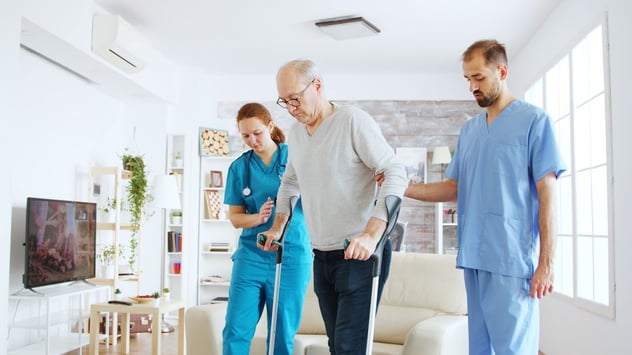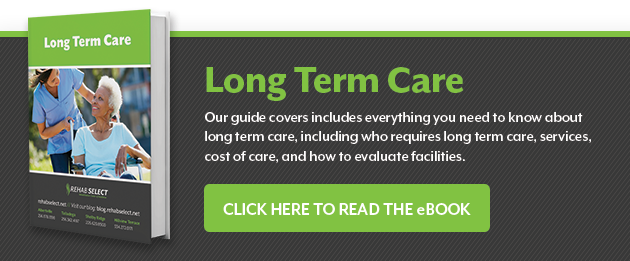
Well over two million people in the United States live with a neuromuscular disorder such as Parkinson’s, Multiple Sclerosis, muscular dystrophies, and myopathies. These genetic conditions affect muscles and the neurons that fire them. Because there are no cures for these conditions, a diagnosis can be especially daunting, but many of their effects can be combated with our medically diverse set of therapies.
What is Neuromuscular Therapy?
At Rehab Select, we help our patients live meaningful lives with neuromuscular disorders, maintaining or regaining foundational abilities and adapting aspects of their lives to make them more functional.
The most common symptom of a neuromuscular disorder is simply muscle weakness. As muscle weakness progresses, it can start to threaten a patient’s ability to move through a full range of motion and to stabilize the trunk to balance when walking, pick up the feet, maintain posture, produce speech, swallow, etc. We are more than our muscles, but they are always in the background, supporting our higher functions; sufferers can become socially isolated, depressed, and unable to perform basic functions over time. Our neuromuscular therapy programs offer hope in a holistic approach to dealing with symptoms on an individual basis, to restore confidence and set goals for a more independent future.
Therapies can be implemented by speech language pathologists, physical and occupational therapists, psychologists, and nutritionists. We improve physical performance where able, adapt where necessary, and equip patients to maintain a maximum level of control over their ever-changing conditions. Let’s examine six key components of the therapy that we provide to answer the question: What is neuromuscular therapy?
1. Strength Training
At the core of our movements are muscles themselves. According to Yasemin Parlak Demir in the peer-reviewed Neurological Physical Therapy, “The reason for the progressive loss of muscle strength in neuromuscular diseases varies is due to the reduction in the number and size of intrinsic contractile fibers in muscle diseases that are followed by replacement of these fibers by fat infiltration and connective tissue. These changes are caused by the disturbance in the nerve stimulation and transmission pathways necessary for muscle contraction.” Maintaining general strength staves off atrophy, increases the size of muscle fibers, and helps control body fat. Having general strength makes the more practical fine-motor activities of daily living possible. Calisthenics, bands, water training, free weight, and machine resistance exercises may be used in our program, depending on the specific progression of the neuromuscular disorder.
2. Range of Motion and Mobility
Neuromuscular disorder patients usually have a problem with muscle strength loss of contractile ability and using the muscle through its full range of motion. Someone who once could squat to thighs parallel to the ground may now be only able to support themselves through a 45-degree position. Range of motion limitations can become pain and atrophy problems as the disease progresses. When range of motion of the hip flexors or ankle becomes limited, for example, the spine can bear the burden; in another example, bad posture habits can be assumed to compensate for a lack of external shoulder rotation. Mobility can be tested and retested after a variety of stretching and dynamic movement protocols are implemented. Maintaining a range of motion is always easier than regaining it.
3. Gait and Balance Training
According to the authors of Physical exercise in adults with hereditary neuromuscular disease published in the Journal of the Norwegian Medical Association, “Balance training can improve bodily awareness and confidence in maintaining balance, and reduce the risk of falls. Walking aids and other activity aids must be evaluated continuously. This often means balancing the wish to maintain activity levels and independent mobility against the risk of falls and injuries.”
Balance can be trained in a comprehensive way; it’s the inner ear sensing the body’s position, while the trunk and hip flexors respond to negotiate balance. Our patients will improve their general sense of balance through physical therapy and training, but we also analyze walking patterns to cue the best gait for each individual’s abilities. We help to assess the proper walking aids for each patient, as the wrong choice in walking aid can actually disrupt their optimal gait.
4. Skills of Daily Living Training
Some of the biggest strides in regaining confidence can occur in realizing the most taken-for-granted behaviors: brushing your teeth, combing your hair, using utensils. Our therapy methods teach efficient ways to do things that are becoming more difficult, and at the same time, help to innovate devices or sequences to work around changing abilities: jar openers, pen holders, electronic environmental control systems, toilet lifts, handlebars, forks and spoons with thickened handles, and adjustable beds and ever-advancing technological tools.
5. Swallow Study: Eating, Communication Skills
The muscles of the mouth, face, and throat are quintessential to the most basic life skills. We often take for granted the complex activities that result in chewing, swallowing, producing speech, and reacting nonverbally.
Our complete swallow study is a first step in evaluating what the throat and esophagus do when a patient attempts to swallow: ingested barium is visible through an x-ray.
According to the Baltimore Washington Medical Center: Swallowing disorders, also called dysphagia (dis-FAY-juh), can occur at different stages in the swallowing process: Oral phase (manipulating and chewing food), Pharyngeal phase (swallowing reflex, closing of airway), and Esophageal phase (squeezing food into stomach).
We address dysphagia with compensatory training, i.e., technique, and direct strengthening exercises of the muscles involved.
Our physical and occupational therapists have generated an expanding set of testimonials that consistently convey motivational and practical outcomes.
6. Psychological Counseling
Have you ever thought about how important it is to be able to take a walk with confidence in a public park, to eat out without anxiety, to be able to project your voice across a table, and to have the energy to interact with a young child? Almost every activity that constitutes socialization is threatened by a neuromuscular disorder. According to Demir, “In a study of 88 male patients with progressive musculoskeletal dystrophy, it was found that patients had problems in participating in private life and professional life and that more than half of the cases considered themselves to be socially isolated . . . participation problems of these patients were about communication, personal care, and interpersonal relationships.” Of course, depression is commonly found with neuromuscular disorders for this reason and others. Fortunately, according to the Cleveland Clinic’s in-house research, “Depression is a treatable comorbidity in all patient groups in the long term, regardless of the neuromuscular diagnosis.”
That is why our work is necessarily holistic. We strive to keep patients as engaged as possible, as capable as possible, and as optimistic as possible. Our psychological counseling can be extended to family members who also need support in coping with new realities and coordinating ways to increase positivity and continued connections of their family members who suffer from neuromuscular disorders.
Get the Support You Need
When you or a loved one is dealing with the effects of muscular progressive disease, you may ask, “what is neuromuscular therapy?” Our expert team at Rehab Select can help explain the scope of services involved and consult with you to develop a rehabilitation plan. Learn more about what to expect from multi-specialty inpatient rehab. We can share how we care for those with neuromuscular disorders by scheduling a visit here.





